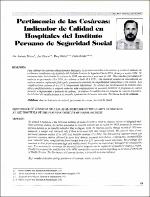| dc.contributor.author | Felices, Antonio | |
| dc.contributor.author | Oporto, José | |
| dc.contributor.author | Malca, Mary | |
| dc.contributor.author | Zelada, Carlos | |
| dc.date.accessioned | 2024-01-03T04:41:09Z | |
| dc.date.available | 2024-01-03T04:41:09Z | |
| dc.date.issued | 1994-12 | |
| dc.identifier.citation | Revista Médica del IPSS. 1994; 3(4). | es_PE |
| dc.identifier.uri | https://hdl.handle.net/20.500.12959/4909 | |
| dc.description.abstract | Para estimar las cesáreas adecuadamente indicadas, los factores asociados a las cesáreas y revisar el estándar de cesáreas se estudiaron ocho hospitales del Instituto Peruano de Seguridad Social IPSS, de mayo a agosto 1994. Se revisaron todas las historias de cesáreas de 1993, una muestra si eran más de 500. Observándose Porcentajes de cesáreas no Pertinentes (3 a 10%), de cesáreas en duda (3 a 21%). Las causas de cesáreas se concentraron en cesárea anterior, sufrimiento fetal agudo, presentación anormal, incompatibilidad cefalopélvica y feto valioso. Las complicaciones variaron de 6 a 21 % (mayormente infecciones). Se concluye que las frecuencias de cesáreas eran altas y multifactoriales; a mayores estancias más complicaciones; es necesario fortalecer el Programa de control Prenatal e implementar el protocolo de cesáreas. Se propone la modificación del estándar de cesáreas dependiendo del nivel del establecimiento y la creación y puntuación del nuevo indicador Pertinencia de la cesárea. | es_PE |
| dc.description.abstract | We studied 8 hospitals of the Peruvian Institute of Social Security in order to estimate the rate of adequatly indicated cesarean section, the factors associated to cesarean sections and to review the IPSS standard for cesarean sections defined as an Quality indicator May to August, 1994. All cesarean section clinical records of 1993 were reviewed, a sample was reviewed only if there were more than 500 clinical records. We observed rates of nonpertinent cesarean section (3 to 10%) and doubtful cesarean (3 a 21%). The first cause of cesarean section was previous cesarean section, followed by acute fetal distress, anormal Presentation, cephalopelvic incompatibility and "valuable" fetus, complications found ranged from 6 to 21% (generally wound infections). We concluded that cesarean section frequencies were high and multifactorial; the greater in hospital stay the higher the complication rate. It is necessary to encourage the Prenatal control Program and to implement protocols for cesarean section. Finally it's proposed the modification of the IPSS standard for cesarean section depending on the level of complexity of Health Service. The Pertinence of Cesarean Section, is proposed as a new indicator. | es_PE |
| dc.format | application/pdf | es_PE |
| dc.language.iso | spa | es_PE |
| dc.publisher | Seguro Social de Salud (EsSalud) | es_PE |
| dc.rights | info:eu-repo/semantics/openAccess | es_PE |
| dc.rights.uri | https://creativecommons.org/licenses/by-nc-sa/4.0/ | es_PE |
| dc.subject | Indicador de calidad | es_PE |
| dc.subject | Pertinemia de cesárea | es_PE |
| dc.subject | Servicios de salud | es_PE |
| dc.subject | Indicator quality | es_PE |
| dc.subject | Pertinence of cesarean | es_PE |
| dc.subject | Service of health | es_PE |
| dc.title | Pertinencia de las Cesáreas: Indicador de Calidad en Hospitales del Instituto Peruano de Seguridad Social | es_PE |
| dc.title.alternative | Pertinence of cesarean section as an indicator of the quality of services at the Hospitals of the Peruvian Institute of Social Security | es_PE |
| dc.type | info:eu-repo/semantics/article | es_PE |
| dc.subject.ocde | https://purl.org/pe-repo/ocde/ford#3.03.02 | es_PE |






